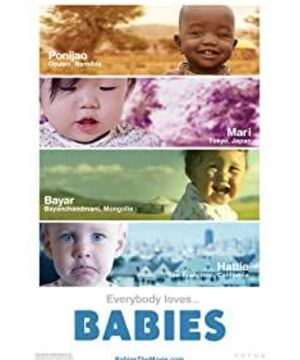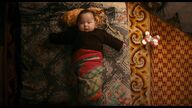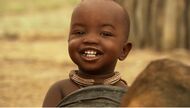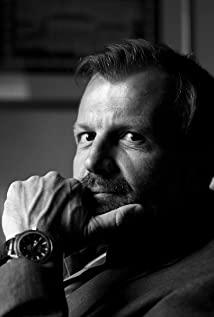The French director Thomas Balmes spent two years going deep into Opwo in Namibia, Bayan Chandman in Mongolia, Tokyo in Japan and Los Angeles in the United States, recording Ponijao, Bayar, Mary respectively. The stages of life from birth to walking for Mari and Hattie. There is no narration in the entire documentary, but a large number of "long shots + simultaneous sound" are used to narrate events. This approach not only maintains the original ecology of life, but also makes the viewer feel immersed in the scene. In the case of no side, the use of later screen text language is particularly important. For example, descriptive on-screen text such as "Near Opuwo ,Namibia" "A few months earlier" "Ponijao" does a good job of explaining places, people and times before the first baby. The theme of the film is more prominent through the accumulation of the symbols of the film's own material.
The director uses a cross-sectional parallel structure thinking to show the different growth processes of the four children in the same period in a horizontal relationship. The children are connected and contrasted by unfolding narratives in crossovers. It presents the life segments of children born in different regions and families. Although the living environment, sanitary conditions and education methods are different, each child grows up healthily in their own way.
The text is generally a system of symbols, and the meaning of the program comes from the symbols, from the converging symbol system. The film can convey symbolic information through the picture, the length of the shot, the depiction of the background, music, and language. This article attempts to use semiotics to explore the value and significance of this documentary by analyzing its characters, music and contemporaneous voices, camera language, and different cultures.
Semiotic Analysis of Characters
Even without narration, viewers can still distinguish the babies in four different places very well. This is because of the full use of symbols in documentaries to help the audience make distinctions. In semiotic analysis, the division between content and form is arbitrary and temporal, and we focus on the symbolic systems that make up the text. Therefore, many things in the documentary can convey the symbolic system of social environment and nationality.
On the premise of the explanatory screen text "Near Opuwo, Namibia, Near Bayanchandmani, Mongolia, tokyo, Japan and San Francisco, USA" at the beginning, the viewer can adapt well to the four regional scenes and characters according to the following symbols. convert. Black skin, mud houses, red mud smeared on the body, heavy metal bracelets fully reflect the face of Namibia. The combination of blue sky, white clouds, cows, horses, sheep, yurts, motorcycles, yellow skin, single eyelids, and a sunburned face is a symbol of Mongolia. The densely lit buildings, the rushing streets, the delicate rooms, the yellow skin and the Japanese language are all symbols of Japan. Hospitals with state-of-the-art equipment, white skin, deep light eyes, and yellow hair are all symbols of America.
In addition, body language, movements, facial expressions, and the way people pronounce are symbols that we use to "read" people, that is, try to gain insight into their temperament, personality, and values.
Ponijao from Namibia plays happily with his older brother and sister, lifts his veil after seeing his brother's body, and can entertain himself when he is alone. Ponijao ( Ponijao) is a curious and lively child.
Music and Synchronization
Music and sound effects are used to elicit a specific response from the audience. A phrase or a sound is the signifier, and the emotion it brings is the signified. The role of music and sound is to suggest how viewers should feel about what they see.
From the beginning, the documentary is brought in with cheerful music, which makes people feel pleasant and relaxed. Then, when the mother is breastfeeding, the background music is replaced by slow and long music, which makes people feel warm and makes people feel the mother's love. After that, cheerful music was used many times in the film, for example, when the child crawls, plays or learns to walk, people can't help but feel that the child is smart and cute. Especially in the last shot, Mongolia's Bayar slowly stands up in the wind, his laughter combined with cheerful music makes people feel happy for his growth. In addition, the cheerful music can also speed up the rhythm of the film, making up for the tediousness caused by too many long shots.
A large number of simultaneous sounds are preserved in the documentary, such as the crying and laughter of the baby, the sound of adults chatting, the frolic of children playing, the sound of mother coaxing the baby, and the sound of the baby babbling later. Although these sounds do not convey information on the surface, especially the languages of different countries we cannot understand, but we can feel the different emotions brought by their voice intonation. For example, the voice of the Namibian mother holding Ponijao and teaching him to speak and the Mongolian mother scolding Bayar for overturning the bucket. Although I don't know exactly what they said, I can feel different emotions from the tone of voice.
Lens language close-
ups, panoramas and long-range views are used extensively in this documentary.
Hattie in Los Angeles, USA, used a close-up as she was picked up by her mother shortly after her birth. Hattie slowly opened her eyes and then closed them again, suddenly sticking out her tongue and grinning. This shot expresses the meaning of intimacy, clearly seeing her subtle facial expressions.
Bayar from Mongolia used the panorama when he was beaten by his brother with a cloth strip in the house. The brother picked up the cloth strip and slapped Bayar continuously until his brother cried and stopped moving, but his brother When not crying, the elder brother continued to beat the younger brother, during which the elder brother also watched the camera several times. This shot is a good representation of the bullying and being bullied relationship between the older brother and younger brother.
Mongolia's Bayar crawled under the clothes to dry and used a long-range lens. The picture outlines that Bayar is in the blue sky and white clouds and the boundless grassland. Mari in Japan used a pulling lens when she stood up in the park, the scene was slowly expressed, the panorama slowly transitioned to the distant view, and the tall buildings behind Mari also appeared slowly.
In addition, most of the shooting angles in the film are flat-shot angles aimed at children, which make people feel equal and cordial. In this perspective, the audience may not consciously compare and think about the different parenting environments in addition to being moved by the cute and fresh scenes.
In the cut of the shot, the mother in Namibia is sitting on the ground with Ponijao to eat, but there are flies lingering around, the puppy licks the feet of the mother's dissatisfied yellow mud, and when Ponijao pulls the feces While on Mom's lap, Mom just wipes with the corncob. At this time, the picture immediately turned to the United States. A tidy house, books, bathing in the bathtub, etc., the superior living environment is in stark contrast to the former.
In Japan, Mari owns a lot of toys, but in the process of playing alone, she suddenly throws the toys away and starts crying. The screen suddenly switches to Bayar, a Mongolian child who is also alone but happily playing with paper rolls. ). At this time, the screen switches to Japan again, and Mari is crying while playing. The camera moves to Bayar laughing while eating a scroll. It was cut in half like this five times. Later, the speed of lens switching became faster and faster, and the contrast became more and more obvious. The cuts of these shots connect Beja and Marie, and contrast their different personalities.
Cultural
culture, that is, the coding system, plays an important role in people's lives. All four countries have different cultural backgrounds, which makes them react differently to the same event.
For example, for bathing, due to the lack of water resources, mothers in Namibia will lick their children clean with their tongues, while in Mongolia, Mongolian mothers will smear their children's faces with milk after cleaning them.
In terms of living, the Namibian house is built with mud above and supported by wooden slats below. Mongolia is convenient for moving yurts, surrounded by cattle, horses and sheep. Japan lives in urban high-rise buildings, while America lives in single-family villas.
In terms of education, due to the underdeveloped education in Namibia and Mongolia, there is no picture of Ponijao and Bayar receiving education in educational institutions. However, in the United States and Japan, the level of education is relatively developed, so we will find that parents in the United States and Japan will take them to study in educational institutions.
Epilogue
Throughout the entire documentary, based on the semiotic analysis of the characters, music and simultaneous sound, lens language and culture, we not only saw the process of the four children from birth to walking, but also saw four different countries and different living environments. four children of different characters under. Through the lens of director Thomas Balmes, we can see the interesting side of children, but also see things that are usually not noticed.
View more about Babies reviews








